Your Call?
Which of today’s featured images do you like best? Let us know why? I have a clear winner.
My Call
In Saturday’s blog post, my two favorites were Image #1 for the soft pinks, the high key look, and the goofy flight pose and Image #2 for the sweet light and flight pose, the marsh grasses in the upper left, and the reflection of the dark cloud in the lower right.
So, what is the main reason that I have been going to the 400 f/2.8 and forsaking the 200-600? What I love most about the 400 f/2.8 is the speed. Especially in low light conditions, when I can begin making sharp images earlier than I could with other slower lenses. As far as the gorgeous backgrounds, those are due more to the distance from the subject to the background than the aperture. On a related note, I have responded to each of the comments left on the last blog post.
Apologies for the rather lame April Fool’s Day joke. I did not realize the date until the last minute, so I came up with the musical career idea. Bob Handin has, late in life, learned to play the cello quite well. But not I, and at present I have no plans of doing so.
What’s Up?
On Saturday morning, Bob Handin enjoyed a banner day at ILE with the baby cranes and one of the two young eagles. On Saturday afternoon, I visited the North Tampa rookery and did well on flight once it clouded over. On Sunday morning, conditions at DeSoto were as close to terrible as you can get with a brisk west wind. But some foggy clouds that came and went in the eastern sky made things tolerable and we were able to make a few strong images despite the wind against sun conditions.
I am back home today, Monday 3 April 2023. I will be headed down to the lake soon. This blog post took about two hours to prepare including the time spent on the image optimizations. Wherever you are and whatever you are doing, I hope that you too have a great day.
Please remember to use the B&H and Amazon links that are found on most blog pages and to use the BIRDSASART discount code at checkout when purchasing your new gear from Bedfords to get 3% back on your credit card and enjoy free second-day air FedEx. Please, also, consider joining a BAA IPT. You will be amazed at how much you will learn!
You can find some great photo accessories (and necessities, like surf booties!) on Amazon by clicking on the Stuff tab on the orange/yellow menu bar above. On a related note, it would be extremely helpful if blog-folks who, like me, spend too much money on Amazon, would get in the habit of clicking on the Amazon logo link on the right side of each blog post when they shop online. As you might expect, doing so will not cost you a single penny, but would be appreciated tremendously by yours truly. And doing so, works seamlessly with your Amazon Prime account.
Please remember that if an item — a Delkin flash card, or a tripod head — for example, that is available from B&H and/or Bedfords, is also available in the BAA Online Store, it would be great, and greatly appreciated, if you would opt to purchase from us. We will match any price. Please remember also to use my B&H affiliate links or to earn 3% cash back at Bedfords by using the BIRDSASART discount code at checkout for your major gear purchases. Doing either often earns you free guides and/or discounts. And always earns my great appreciation.
|
|
|
This image was created on 28 March on the first morning of the first DeSoto IPT. While seated on the sand, I used the knee-pod technique with the handheld Sony FE 400mm f/2.8 GM OSS lens Tracking: Zone/AF-C with Bird Face/Eye detection enabled performed to perfection. Be sure to click on the image to enjoy a high-res version. Little Blue Heron — juvenile hunting fiddler crabs |
Working the Subject
There were not a lot of birds early on the first day of the IPT, but this juvie Little Blue Heron made our morning. We photographed it posing, high-stepping, hunting, striking, catching tiny fish and fiddler crabs, and being wary. I have enough images do a video to illustrate that it is important to stay with a subject for extended periods of time in order to capture a wide range of behaviors. Making one image of a bird and then stating, “I got that bird” does not cut it for me.
|
|
|
This image was created on 28 March on the first afternoon of the DeSoto IPT. While seated on the grass, I used the Robus RC-5558 Vantage Series 3 Carbon Fiber Tripod/Levered-Clamp FlexShooter Pro-mounted Sony FE 600mm f/4 GM OSS lens with the Sony FE 1.4x Teleconverter, and The One, the Sony Alpha 1 Mirrorless Digital Camera.. ISO 2000. The exposure was determined by Zebras with ISO on the rear wheel: 1/2500 second at f/5.6 (wide open) in Manual mode. RawDigger showed that the exposure was dead-solid perfect. AWB at 5:56:30 am on cloudy bright afternoon. Tracking: Spot S/AF-C with Bird-Eye/Face Detection performed perfectly. Click on the image to enjoy the high-res version. Image #2: Short-billed Dowitcher — adult basic (winter) plumage ruffling |
Afternoons at DeSoto?
My favorite afternoon spot at DeSoto as detailed in the DeSoto Site Guide paid off handsomely as Bob Handin and I got to photograph a nice variety of shorebirds at relatively close range thanks to the high tide. When a bird begins to ruffle, be sure to press and hold the shutter button until it quits. And that is true no matter the frame rate of your camera body.
High Level “Why?” Question
Why do I wish that this bird had waited one more second before it began ruffling?
|
|
|
This image was created on 30 March 2023 on the last morning of the first DeSoto IPT. Crouching a bit to get the background I wanted, I used the handheld Sony FE 70-200mm f/2.8 GM OSS II lens with the Sony FE 2x teleconverter (at 364mm), and The One, the Sony Alpha 1 Mirrorless Digital Camera.. The exposure was determined via Zebras. ISO 1250: 1/640 sec. at f/5.6 (wide open) in Manual mode. AWB at 7:41:54am as a clear morning in sweet light. Tracking: Expand Spot AF/C with Bird-Eye/Face Detection performed perfectly. Click on the image to enjoy a high-res version. Image #3: Laughing Gull — adult breeding plumage calling |
Butter Light
I love the sweet color of the light for the first thirty minutes on a clear morning. The sun was so low in the sky that we needed to make sure that our shadows did not cover the birds or otherwise appear in the frame. In general, I tone down the yellows while striving to maintain the look of the EML, the early morning light.
|
|
|
This image was created also on 30 March 2023 on the last morning of the first DeSoto IPT. Standing at full height, I used the handheld Sony FE 70-200mm f/2.8 GM OSS II lens with the Sony FE 2x teleconverter (at 400mm), and The One, the Sony Alpha 1 Mirrorless Digital Camera.. The exposure was determined via Zebras. ISO 1600: 1/5000 sec. at f/5.6 (wide open) in Manual mode. AWB at 8:06:32am as a sunny morning. Tracking: Zone AF/C with Bird-Eye/Face Detection performed perfectly. Click on the image to enjoy a high-res version. Image #4: Snowy Egret — one year-old fly-by |
Adjusting on the Fly
I had been photographing some Ruddy Turnstones when I noticed this Snowy Egret take flight and head right toward sun angle. I quickly spun the shutter speed dial three clicks to ensure a pretty good exposure and avoid toasting the bird’s very bright whites. I fired off about fifteen frames. I kept only this one.
Unsolicited via e-mail from Pete Myers
I just spent 4 days in the field in a graduate course in bird photography taught by Artie Morris at Fort DeSoto. After almost 50 years of experience pointing cameras at birds from the Arctic to Tierra del Fuego, New Zealand and beyond, I thought I was good enough. But what I learned from Artie in just four days has taken me to a whole new level. As he aptly puts it, “birds as art,” not simply bird photography. One of those 4 days was the most satisfying I’d ever experienced, anywhere. The IPT left me euphoric about what I’d learned, and frighteningly committed to recreating my portfolio with the techniques and insights he taught me.
Unsolicited via e-mail from IPT veteran Eugen Dolan
Arthur, Thank you very much for your overwhelming infectious enthusiasm that helped get me up on some mornings. Also, your ability to express yourself- and explain in great detail why you like or may not like an image – was very helpful in allowing me to better analyze my images. Eugen
Via e-mail from Jim Miller
I can’t stop thinking about how much fun the DeSoto IPT was, and how much I learned. There were so many things that suddenly made perfect sense after I had been confused for so long. Thank you very much for the wonderful trip, and for being a great teacher. As I worked through the raw files last week, I realized what a fantastic lens the 600 IS is. Thanks for the rental! Maybe someday I will be able to afford one. Some images for critique are attached. Thank you again, Artie. It was really wonderful to be with you and learn from you.
Via e-mail from Lee Sommie
I want to thank you for making the Fort DeSoto IPT; it was a fun and educational experience for me. I truly did not want the adventure to end. I now look through the viewfinder with an artist’s mindset. And the real bonus was making new friends with fellow students. Thank you for sharing your knowledge and enthusiasm for wildlife photography. I had a great time with you and look forward to more adventures on future IPTs.
Via e-mail from Muhammad Arif
I had a great time at Fort De Soto. Thank you for all the instruction, for your help and pointers; my photography has already improved tremendously, and I’ve never made such good bird photos before. I wish I could’ve joined you on Monday and Tuesday morning as well, but work got in the way. It was also nice meeting the folks on the IPT. Thanks again for everything and I hope to join you at a future IPT sometime again.
|
|
|
Fort DeSoto in spring is rife with tame birds, many in full breeding plumage. Click on the composite to enjoy a larger version. Clockwise from upper left around to center: Laughing Gull landing on head of Brown Pelican, Laughing Gull in flight, Reddish Egret sunrise silhouette, Great Blue Heron with needlefish, Yellow-crowned Night Heron with ghost crab, Roseate Spoonbill, Sanderling in breeding plumage, and white morph Reddish Egret in glorious breeding plumage. |
The 2023 Spring Fort DeSoto Instructional Photo Tours (IPTs)
Spring Fort DeSoto IPT #2: Tuesday 11 April through the morning session on 14 April 2023. 3 1/2 Days: $1899.00 includes three working brunches. Limit six photographers/Openings: 4.
Spring Fort DeSoto IPT #3: Tuesday 9 May through the morning session on 12 May 2023. 3 1/2 Days: $1899.00 includes three working brunches. Limit six photographers/Openings: 5.
Fort DeSoto, located just south of St. Petersburg, FL, is a mecca for terns and gulls, wading birds, and shorebirds in spring. Many of the birds will be in full breeding plumage. Simply put, DeSoto is the new Ding Darling. Migrant shorebirds are in abundance, and many are exceedingly tame. We should have great chances on Royal and Sandwich Terns and both white- and dark-morph Reddish Egrets. Great Egret, Snowy Egret, Great Blue Heron, Tricolored Heron, and White Ibis are easy as well and we will almost surely come up with a tame Yellow-crowned Night-Heron or two along with some American Oystercatchers. We will enjoy lots of great flight photography, especially with the Brown Pelicans.
|
|
|
Again, Fort DeSoto in spring is rife with tame birds, most in breeding plumage. Click on the composite to enjoy a larger version. Clockwise from upper left around to center: Laughing Gull in flight, Yellow-crowned Night-Heron, Sandwich Terns copulating, Roseate Spoonbill, Great Egret with reflection, breeding plumage Short-billed Dowitcher, American Oystercatcher, Royal Tern, white morph Reddish Egret, and Snowy Egret in marsh. |
In Addition!
We should also get to photograph a variety of other shorebirds including Black-bellied, Semipalmated, Wilson’s, Snowy, and Piping Plovers, Willet, Dunlin, Short-billed Dowitcher, Marbled Godwit, and most especially, Red Knot, with many individuals in their handsome breeding plumages. In spring the T-shaped peninsula and the newly formed sandbar, Outback Key, are literally packed with avian treasures.
With just a bit of luck, we may get to photograph one of Florida’s most desirable species: Roseate Spoonbill. And we will surely get to do some Brown Pelican flight photography. With luck, they will have Laughing Gulls landing on their heads. And though not guaranteed, Wood Stork might well be expected. And we will be on the lookout for a migrant passerine fallout in the event of a thunderstorm or two.
|
|
|
Yes, Fort DeSoto in spring is rife with tame birds, most in breeding plumage. Click on the composite to enjoy a larger version. Clockwise from upper left around to center: breeding plumage Dunlin, dark morph Reddish Egret displaying, Laughing Gull vertical front-end portrait, Laughing Gull with prey item, landing on head of Brown Pelican, breeding plumage Royal Tern displaying, Royal Terns — pre-copulatory stance, Laughing Gulls copulating, Laughing Gull head portrait, breeding plumage Sandwich Tern with fish, and a rare treat, a breeding plumage White-rumped Sandpiper. |
What You Will Learn on a DeSoto IPT
- 1- The basics and fine points of digital exposure; how to get the right exposure every time after making a single test exposure (or before if you are using SONY gear).
- 2- How and why to work in Manual mode (even if you’re scared of it).
- 3- How to approach free and wild birds without disturbing them.
- 4- Lots about bird behavior and how to use that knowledge to help you create better images.
- 5- To age and identify many species of shorebirds including various sandpipers, plovers, dowitchers, and possibly yellowlegs.
- 6- To spot good situations and to choose the best perspective.
- 7- To see, evaluate, and understand the light.
- 8- To design pleasing images by mastering your camera’s AF system.
- 9- And perhaps most importantly, to evaluate wind and sky conditions and understand how they affect bird photography.
- 10- More than you could ever imagine.
|
|
|
You got it by now! Fort DeSoto in spring is rife with tame birds, most in breeding plumage. Click on the composite to enjoy a larger version. Clockwise from upper left around to center: Roseate Spoonbill, immature Brown Pelican in flight, the heron/egret hybrid, American Oystercatcher feeding, immature Royal Tern on railing, Great Egret morning silhouette, Black Skimmer in surf, and underside head portrait of Great Blue Heron. |
The Details
Morning sessions will run two and one-half to three hours; afternoon sessions about two. There is never a set schedule on an IPT — we adapt to the conditions. On cloudy mornings with the right wind, we may opt to photograph till noon and skip the afternoon session. That especially when the afternoon weather is looking iffy. We may opt to visit a great North Tampa rookery if conditions warrant that.
There will be a Photoshop/Image Review session before and after brunch (included) each of the three full days. That will be followed by Instructor Nap Time. Each of these IPTs will run with only a single registrant as I do not like disappointing anyone. The best airport is Tampa (TPA). Once you register, you will receive an e-mail with lodging information. Do know that it is always best if IPT folks stay in the same general area (rather than at home or at a friend’s place a good distance away).
Folks attending this IPT will be out in the field as early as possible and stay out late to take advantage of sunrise and sunset colors; this is pretty much a staple on almost all BIRDS AS ART Instructional Photo-Tours. Doing so will often present unique photographic opportunities, opportunities that will be missed by those who need their beauty rest and those who need to get home for a proper dinner. I really love it when I am leaving the beach at 9:30am on a sunny morning after a great session just as a carful or two of well-rested photographers are arriving … We will be getting wet.
Your $599 deposit is due now. Credit cards are OK for that. You can register by calling Jim or Jennifer during weekday business hours at 863-692-0906 with a credit card in hand. Once you leave a deposit, you will receive an e-mail with your balance statement and instructions for sending your balance check three months before the trip begins. If you wish to pay in full right off the bat, you can make your check out to BIRDS AS ART and send it via US mail here: BIRDS AS ART, PO BOX 7245, Indian Lake Estates, FL 33855. You will receive a confirmation e-mail with detailed instructions, and clothing and gear advice two months before the trip. Please shoot me an e-mail if you plan to register or if you have any questions.
IPT veterans and couples or friends signing up together may e-mail for discount information.
Typos
With all blog posts, feel free to e-mail or to leave a comment regarding any typos or errors.

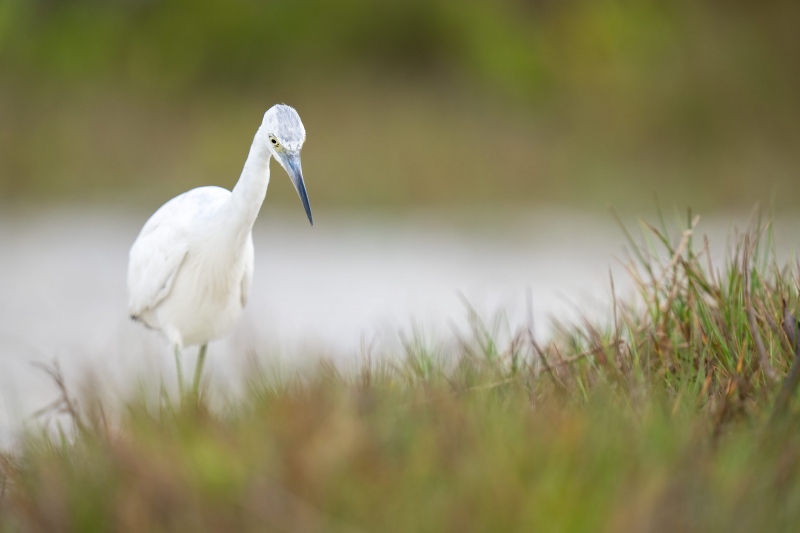
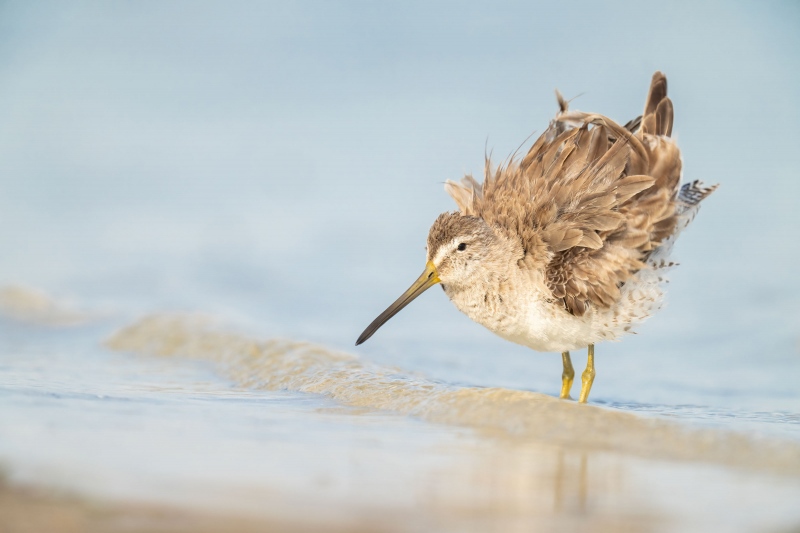
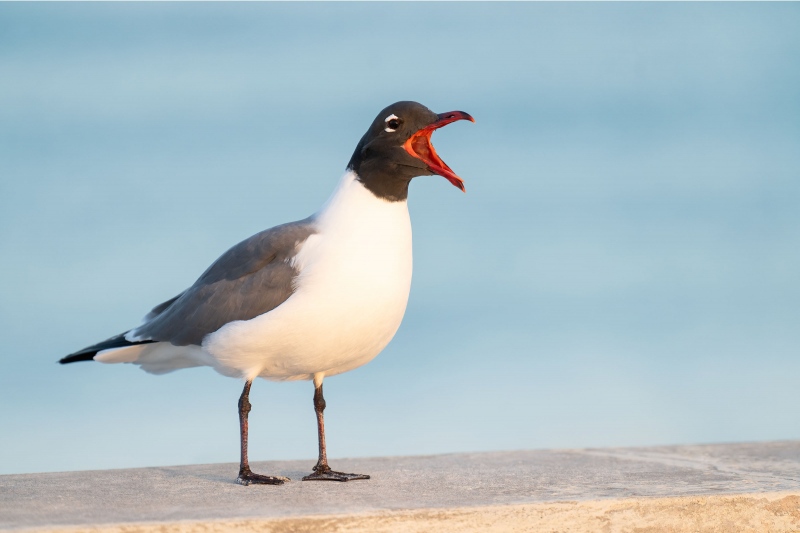
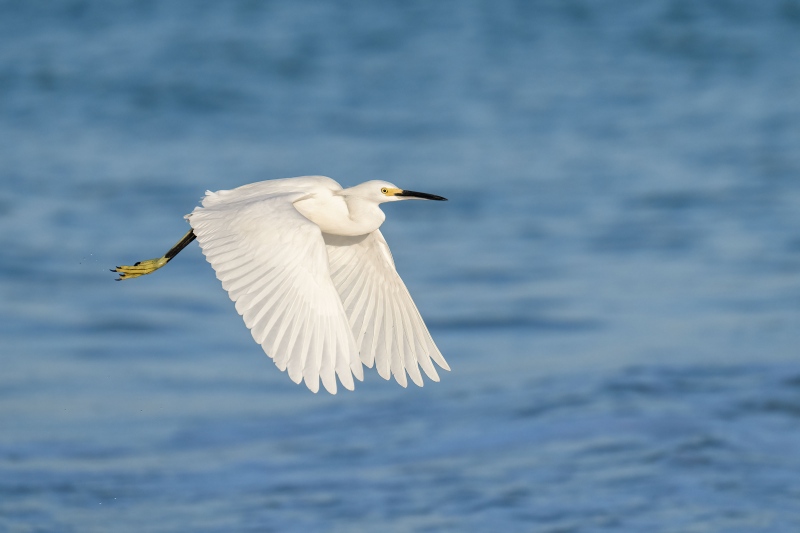
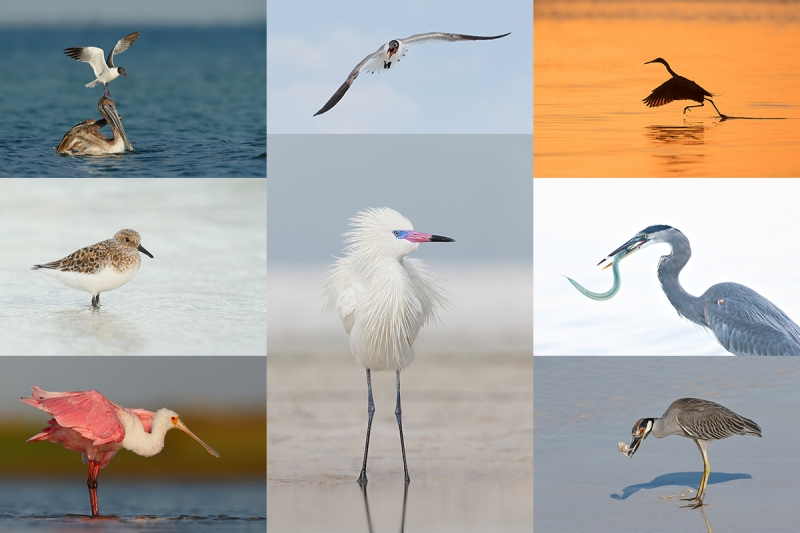
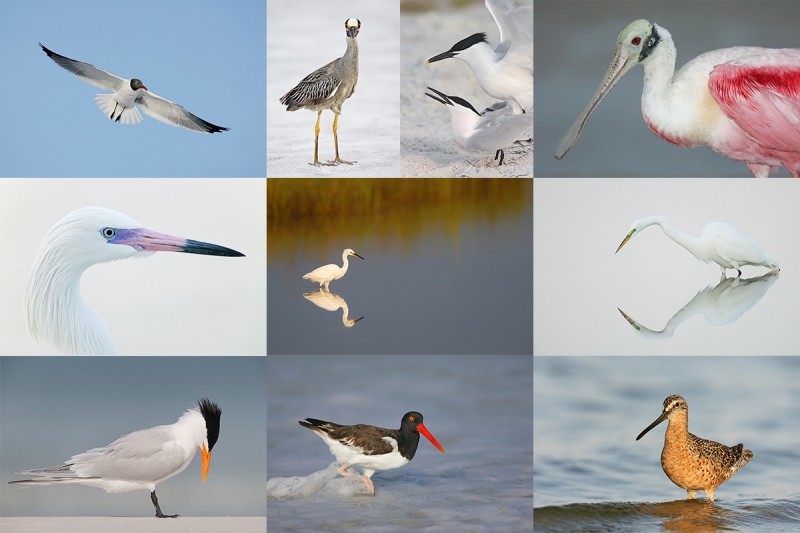
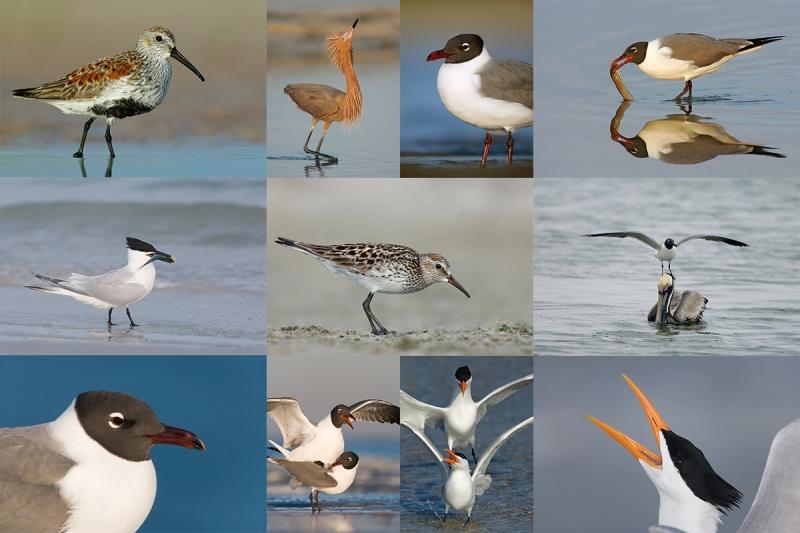
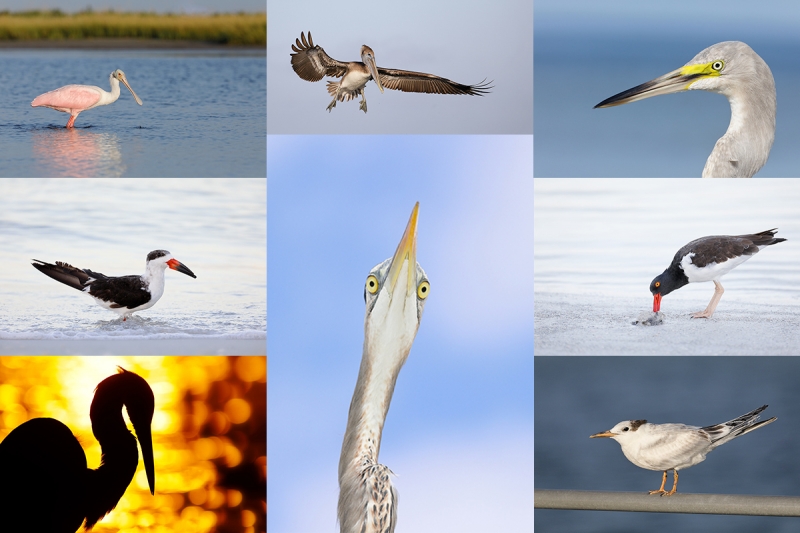













I’m leaning on the little blue shot as my least fav, and after that a toss up. I really like the buttery light and the rufflel shot as well. I’m rather fond of Snowy Egret’s as one of my favorite birds. Just wondering how you know one year old? Lack of pink between the bill and eyes? Inquiring minds want to know how you can age this beautiful bird? Thanks
Enlarge the image and you will see a bit of the yellow stripe on the back of the leg that indicates a one-year-old SNEG. The pink lores are seen only on breeding plumage birds.
a
Impressive, and thanks for replying to my novice question. I learned something I didn’t know about the yellow streaks on the back of the legs. When I phrased the question I was having a brain fade moment and could not think of the word lore fore the pink on breeding birds.
Thanks again for sharing your expertise and putting up with our (my) lame questions.
All 4 images are interesting and well made! Image #3: Laughing Gull makes me laugh too seeing what the Gull is doing! HaHaHa!!
Artie
They are all pretty sweet however I am liking the Fly-By #4 & the Gull #3 calling out or Laughing :-). You are getting pretty good at your flight shots, keep firing away!
I think the wave would have been near gone in a second rendering the water smooth and a gooder photo. 🙂
Always with love b
Much gooder.
with love, a
to me they are all beautiful when I look it put a smile on my face
love your sis
Q – Why do I wish that this bird had waited one more second before it began ruffling?
A – You’d rather have the receding wavelet behind the bird’s feet.
Not exactly. The wave was just breaking …
with love, a
To let the little wave get away from the birds feet?
Good but be more specific.
with love, a
Wonderful set and some great photo advice today, Art! I’d have to say that images #3 and #4 are my faves and it would be hard for me pick an overall winner. They are both superb..
I’m thinking that you would have liked the small wave to roll out completely in the Dowitcher image!
Thanks, Chris. You got my two favorites. And you are on the right track with the wave.
with love, artie